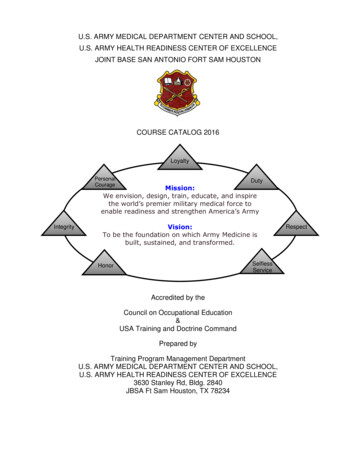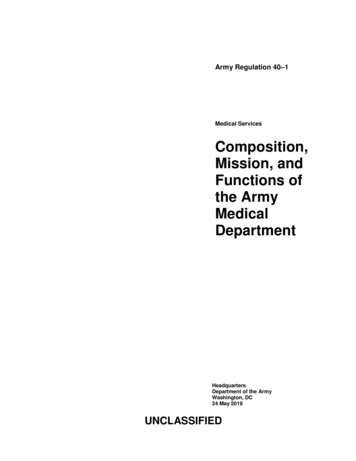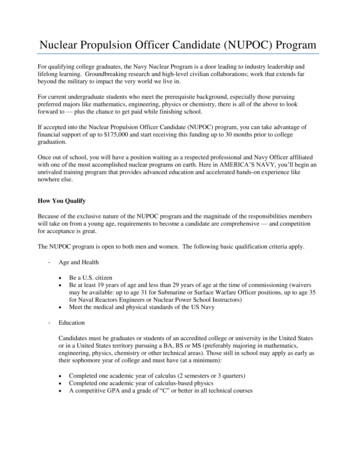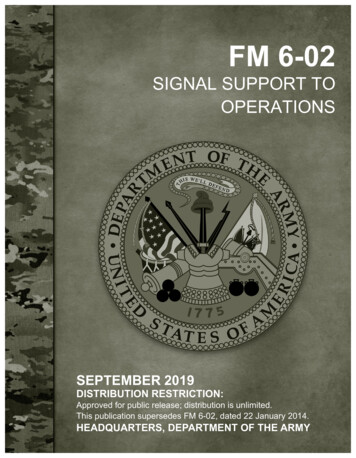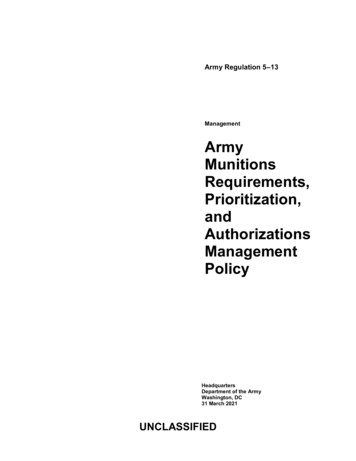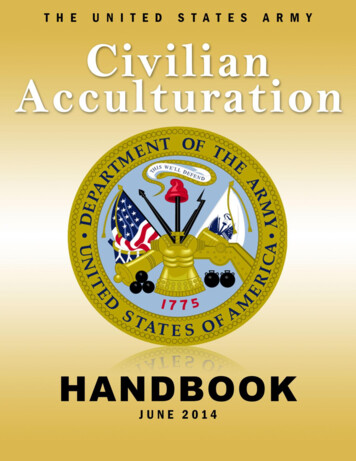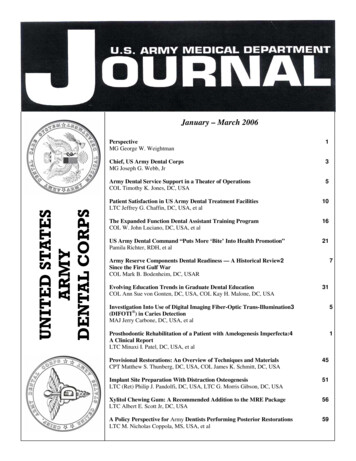
Transcription
UNITED STATESARMYDENTAL CORPSJanuary – March 2006PerspectiveMG George W. Weightman1Chief, US Army Dental CorpsMG Joseph G. Webb, Jr3Army Dental Service Support in a Theater of OperationsCOL Timothy K. Jones, DC, USA5Patient Satisfaction in US Army Dental Treatment FacilitiesLTC Jeffrey G. Chaffin, DC, USA, et al10The Expanded Function Dental Assistant Training ProgramCOL W. John Luciano, DC, USA, et al16US Army Dental Command “Puts More ‘Bite’ Into Health Promotion”Pamila Richter, RDH, et al217Army Reserve Components Dental Readiness — A Historical Review2Since the First Gulf WarCOL Mark B. Bodenheim, DC, USAREvolving Education Trends in Graduate Dental EducationCOL Ann Sue von Gonten, DC, USA, COL Kay H. Malone, DC, USA31Investigation Into Use of Digital Imaging Fiber-Optic Trans-Illumination3(DIFOTI ) in Caries DetectionMAJ Jerry Carbone, DC, USA, et al5Prosthodontic Rehabilitation of a Patient with Amelogenesis Imperfecta:4A Clinical ReportLTC Minaxi I. Patel, DC, USA, et al1Provisional Restorations: An Overview of Techniques and MaterialsCPT Matthew S. Thunberg, DC, USA, COL James K. Schmitt, DC, USA45Implant Site Preparation With Distraction OsteogenesisLTC (Ret) Philip J. Pandolfi, DC, USA, LTC G. Morris Gibson, DC, USA51Xylitol Chewing Gum: A Recommended Addition to the MRE PackageLTC Albert E. Scott Jr, DC, USA56A Policy Perspective for Army Dentists Performing Posterior RestorationsLTC M. Nicholas Coppola, MS, USA, et al59
A Professional Publicationof the AMEDD CommunityOnline issues of the AMEDD Journal are available at spx?type 1January – March 2006The Army Medical Department Center & SchoolPB 8-06-1/2/3LTG Kevin C. KileyThe Army Surgeon GeneralCommander, US Army Medical CommandMG George W. WeightmanCommanding GeneralUS Army Medical Department Center and SchoolBy Order of the Secretary of the Army:Official:JOYCE E. MORROWAdministrative Assistant to theSecretary of the ArmyDISTRIBUTION: SpecialThe Army Medical Department Journal [ISSN 1524-0436] is published quarterly forThe Surgeon General by the US Army Medical Department Center & School, ATTN:MCCS-DT, 2423 FSH-Hood ST, Fort Sam Houston, TX 78234-5078.CORRESPONDENCE: Manuscripts, photographs, official unit requests to receivecopies, and unit address changes or deletions should be sent to the Journal at theabove address. Telephone: (210) 221-6301, DSN 471-6301DISCLAIMER: The Journal presents clinical and nonclinical professional informationto expand knowledge of domestic & international military medical issues andtechnological advances; promote collaborative partnerships among Services,components, Corps, and specialties; convey clinical and health service supportPETER J. SCHOOMAKERGeneral, United States ArmyChief of Staff0601004information; and provide a peer-reviewed, high quality, print medium to encouragedialogue concerning healthcare initiatives.Views expressed are those of the author(s) and do not necessarily reflect official USArmy or US Army Medical Department positions, nor does the content change orsupersede information in other Army Publications. The Journal reserves the right to editall material submitted for publication (see inside back cover).CONTENT: Content of this publication is not copyright protected. Material may bereprinted if credit is given to the author(s).OFFICIAL DISTRIBUTION: This publication is targeted to US Army MedicalDepartment units and organizations, and other members of the medical communityworldwide.
PerspectiveMajor General George W. WeightmanWelcome to the latest edition of our AMEDD Journal.I’m convinced that you will find this issue to beunique, interesting, and professionally stimulating.This quarter’s issue is devoted to the Army DentalCorps and we have selected a broad spectrum ofarticles to demonstrate the breadth and depth of thisgreat Corps. MG Joseph Webb, the Dental Corps Chiefand Deputy Surgeon General, starts us off with ahistory of the Dental Corps. You may be surprised tolearn that it was formally established (by law) in 1911.He gives us a very interesting overview of the Corpswith a description of its many areas of therapeutics,research, and graduate dental education programs. Healso provides insightful comments on three newinitiatives: the Oral Health Initiative, DigitalRadiography, and the Expanded Function DentalAssistant programs.COL Tim Jones follows with a great overview ofOperational Dentistry in his article titled “ArmyDental Service Support in a Theatre of Operations.”Many of you will be surprised to realize thathistorically 20% to 25% of all Soldiers experiencedental emergencies within a year while deployed. COLJones concludes that military dentistry clearly mustaccompany the Warfighter and is an integral part inmaintaining Soldier readiness.LTC Chaffin reassures us of the top notch quality ofdental care in the Army with his “Patient Satisfactionin US Army Dental Treatment Facilities.” He providesdocumentation of excellent care that is being providedfrom a patient’s perspective and also identifies futureareas of study. COL John Luciano, tells us of thehistory and status of “The Expanded Function DentalAssistant Training Program” and stresses the greatreturn on investment and increased access to care thatthis program has delivered to the AMEDD.“US Army Dental Command ‘Puts More “Bite” IntoHealth Promotion’” provides us the why and how ofputting Health Promotion Programs into dentalpractice. Pamila Richter explains the partnershipbetween the Dental Command and the Army Centerfor Health Promotion and Preventive Medicine thathas been very proactive in delivering state of the arthealth education to our beneficiaries. COL MarkBodenheim in “Army Reserve Components DentalReadiness — A Historical Review Since the First GulfWar” gives us the unvarnished truth about the poorstate of reserve dental readiness prior to the GlobalWar on Terror and documents the recentimprovements. He outlines some of the remainingchallenges to getting dental readiness parity betweenthe Active and Reserve Components.In “Evolving Education Trends in Graduate DentalEducation” COL Ann von Gonten describes GDEfrom entry programs all the way through the manydental fellowships. She gives great advice on theservice obligations incurred for training and details theselection process. MAJ Jerry Carbone describes a newand potentially better method for detecting cariescompared to the traditional bitewings in his articleentitled “Investigation Into Use of Digital FiberopticTrans-Illumination (DIFOTI) in Caries Detection.”PB 8-06-1/2/3 Jan/Feb/Mar 1
If you’re looking for pictures as proof of the miraclesour dentists are doing in reconstruction you’ll enjoyLTC Minaxi Patel’s “Prosthodontic Rehabilitation of aPatient with Amelogenesis Impecta: A ClinicalReport.” This is an easy read about a rare dentalcondition and the spectacular results achieved throughaggressive reconstruction. CPT Matthew Thunberggives us some good insights into Dentistry 101 with his“Provisional Restorations: An Overview of Techniquesand Materials,” describing three of the most commontypes of materials used and the techniques for usingthem.technique to manage reconstruction of defects of thealveolar ridge. For those of you with (or contemplatinghaving) posterior restorations you’ll enjoy LTCNicholas Coppola’s “A Policy Perspective for ArmyDentists Performing Posterior Restorations.” Dr.Coppola gives us the pros and cons of differentrestoration material and notes the differences betweencivilian and military dental practice. A great read.This is a fantastic edition and I want to take theopportunity to thank all of our great Army Dentists forwhat they do every day to help maintain the readinessof the fighting force. They are pillars of our AMEDDIf you’re not familiar with the term ”Distraction team and clearly set a high standard for the rest of theOsteogenesis” then you need to read “Implant Site Corps to emulate.Preparation with Distraction Osteogenesis” by LTC(Ret) Philip Pandolfi in which he describes a newWARRIOR MEDICS!2 Army Medical Department Journal
Major General Joseph G. Webb, JrMG Webb is Chief, US Army Dental Corpsand Deputy Surgeon GeneralAs the Chief, Dental Corps (DC), I am truly excited tohave this special opportunity to contribute a series ofarticles which showcase our great Soldiers, civilians,leaders, and clinicians, all of whom represent theArmy Dental Care System (ADCS). I believe thecommon thread throughout the Army MedicalDepartment (AMEDD) is the integration of all theCorps (to include the support services) and theirsynergistic relationships. These relationships produce asynchronized system of effective and efficient healthcare delivered in support of Soldiers and theircommanders. The AMEDD Journal is one of manysuperb partners within the AMEDD and we areappreciative of this opportunity.From 1775–1901, dental service to Soldiers wasprovided by hospital stewards (enlisted medics) whoby special interest or special training, limited theiractivities to providing dental care in conjunction withmedical officers. In 1901, the Army authorized 30contract dentists for an Army-wide program of dentalcare. Ten years later, the contract positions wereconverted to commissioned officer positions. TheArmy Dental Corps was officially established on3 March 1911.Concentration: General Dentist (63A), ComprehensiveDentist (63B), Periodontist (63D), Endodontist (63E),Prosthodontist (63F), Public Health Dentist (63H),Pediatric Dentist (63K), Orthodontist (63M), Oral andMaxillofacial Surgeon (63N), Oral and MaxillofacialPathologist (63P), and Executive Dentist (63R).During the past 36 months, the Army’s operationaltempo has been tremendous and demanded a renewedfocus for our personnel and the dental service weprovide to Soldiers at home station and deployed insupport of the Global War on Terrorism. The ADCStreats over 7,200 patients each day in 173 dentalclinics, and is represented by 29 Dental Activities(DENTACs) and 6 Regional Dental Commands, all ofwhich are supported by a single Army DentalLaboratory.The ADCS is not limited to clinical care; it is a multifaceted organization supporting the Army, trainingdentists, and advancing the science of dentistry. Wetrain combat-ready dental technicians from the DentalScience Division. Through Graduate Dental Educationand residency training programs, we provide cliniciansready to treat patients in any environment. Our Dentaland Trauma Research Detachment and CombatDevelopment Directorate ensure that our materiel andforce structure are ready to support the Soldierwherever the requirement exists.The ADCS professional staff, including our dentistsassigned to combat units, consists of 933 dentists, 24MedicalServiceCorpsofficers,1,115noncommissioned officers and enlisted Soldiers, 1,788civilians, and 708 contracted employees. DentalOfficers serve in the following Areas ofThe Dental Command (DENCOM) is the operationalelement responsible for providing dental care and iscurrently implementing the following initiatives toincrease readiness, improve access to care, and,ultimately, support Soldiers and their commanders:PB 8-06-1/2/3 Jan/Feb/Mar 3
First Term Dental Readiness (FTDR). FTDRensures that newly assessed Soldiers receive dentalcare to ensure their deployability upon graduationfrom Advanced Individual Training, One Site UnitTraining, or the Basic Officer Leader Course. Oral Health Initiative (OHI). The OHI is a Tri-Service effort designed to provide routine dentalcare with the express goal of completing all dentaltreatment for Soldiers. The OHI uses allocatedfunds to refer service members to the privatesector for some routine dental care, therebyincreasing the dental wellness of the servedpopulation. All three services are in the first yearof this initiative. Twelve selected ArmyDENTACs have established private sector carenetworks to reduce the backlog of dental needs. DigitalRadiography. The Digital EnterpriseViewing and Acquisition Application (DEVAA)software was developed by DENCOM. DEVAAsupplements existing hardware for imageacquisition, manipulation and diagnostic viewing.The image management enhancement allows allArmy dental digital radiographs acquired in Armydental clinics to be transported and stored in acentral image archive. DEVAA software has beendeployed to over 80 of the Army’s 173 dentalclinics worldwide. Army dental clinics will be100% digitized within the next 12 months. Expanded Function Dental Assistant (EFDA). TheEFDA program is based on labor-substitution4 Army Medical Department Journalprinciples using highly trained dental assistants toincrease the output of general dentistry teams.Personnel from the EFDA program are completelyembedded in both FTDR and Dental CareOptimization (DCO). DCO is a key initiativeaimed at increasing access to care by using thebest clinical practices. EFDAs are also usedextensively to expedite the surge requirements fordental care generated by mobilizations.The Department of Defense and Army environmentwe now face includes challenges of Base Realignmentand Closure, Army Modular Force, QuadrennialDefense Review, Integrated Global Presence andBasing Strategy, and the military-to-civilianconversion. Internal to Army Medicine, volatility isincreased by constrained resourcing, increased use ofprivate sector dental care, recruitment and retentionchallenges, and a possible transition to thedevelopment of a Joint Medical Command. From myrecent conversations with our retired Dental CorpsGeneral Officers, I am amazed at the similarity of thechallenges and issues they faced.The history of US Army Dentistry provides a constantreminder that the personnel of the ADCS are our mostvaluable asset. I am very proud to be a part of a greatteam, doing tremendous work each day. I am confidentwe will respond with a renewed vigor to work throughthe challenges. Together we will reshape the futureand remain an integral partner within the AMEDD.
Army Dental Service Support in aTheater of OperationsCOL Timothy K. Jones, DC, USAWarfighters are the centerpiece of the US Army andare the ultimate weapons system. Their health andfitness, including dental health, is the basic guarantorof military success. The further into a deployment, thegreater the decrease in opportunities and resources toenhance and maintain Soldier health and effectiveness.This makes the emphasis upon preventive medicalsteps employed both before departure and during acontingency deployment even more important. Dentalcare is an integral part of overall Force HealthProtection and shares in the Army Medical Departmentmission to conserve the fighting strength.and bypassed the hospital. Grover et al8 found an evenhigher dental emergency rate among Army recruits —260 per 1,000 Soldiers every 6 months which extendsto a rate of 520 dental emergencies per 1,000 Soldiersper year. Swan and Karpetz9 found a dental emergencyrate of Canadian military personnel in Somalia in 1993to be 232 dental emergencies per 1,000 troops peryear. Lost time due to dental emergencies can have atremendous impact on unit readiness. These historicalcases illustrate the necessity that military dentistrymust accompany warfighters whenever and whereverthey deploy.IMPORTANCE OF FIELD DENTISTRYDENTAL CARE IN THEATER*Historically, 20% to 25% of all Soldiers willexperience a dental emergency during a 1-yeardeployment. The largest number of Soldier complaintsin 1943 involved lack of adequate dental support.1 Inthe Korean War there were 133,720 dental visits thatresulted in 493,441 dental procedures.2 The averagetime a unit loses a Soldier with a dental emergencywhich requires evacuation to the rear is 5 days.3Liewehr4 calculates that this fact leads to a potentialloss to a division of 18,000 man-days during a 1-yeardeployment. Payne and Posey5 found a peacetime fielddental emergency rate at Fort Irwin and Fort Drum tobe 21% of the total medical sick call in field exercisesinvolving 24,500 Soldiers. They further determinedthat the dental emergency rate was 167 per onethousand troops in one year. The result was an annuallost duty time of 121.5 days per thousand Soldiers.Ludwick et al6 found a dental emergency rate of 200dental emergencies per 1,000 deployed personnel peryear in Navy and Marine personnel in Vietnam. Nasserand Storz7 found that 14% of medical sick callreporting to the 12th Evacuation Hospital duringOperation Desert Storm were dental emergencies. Theactual percentage of dental emergencies was higherbecause many Soldiers experiencing dentalemergencies reported directly to field dental clinicsThe type of dental care provided to deployed Soldiersis called operational care, which is composed of“essential” dental care (to prevent a Soldier frombecoming a casualty) and “emergency” dental care.Relief of oral pain, elimination of acute infection,control of life-threatening oral conditions (hemorrhage,cellulitis, or respiratory difficulty) and treatment oftrauma to teeth, jaws, and associated facial structuresare considered emergency care. It is the most austeretype of care and is available to Soldiers engaged intactical operations. Common examples of emergencytreatments are simple extractions, antibiotics, painmedication, and temporary fillings. Essential careincludes dental treatment necessary to interceptpotential emergencies. This type of operational care isnecessary for prevention of lost duty time andpreservation of fighting strength.TYPES OF DENTAL SUPPORTThere are three levels of dental support in a Theater ofOperations; unit, hospital, and area. These levels aredefined primarily by the relationship of the dentalassets attached to the Combat Health Supportsupporting the patient population within each level:*Note: The doctrine of dental operations discussed in this paper is based upon Department of the Army FM 4-02.19,Dental Service Support in a Theater of Operations.PB 8-06-1/2/3 Jan/Feb/Mar 5
Unit — Support provided by a dental team organic todivisional and brigade medical companies and allSpecial Forces Groups. The dental team providesoperational dental treatment to Soldiers during tacticaloperations. The dental team is composed of onegeneral dentist (comprehensive dentist and dentalassistant in the division main medical company) anddental assistant and their field equipment.Hospital — Support provided by the hospital dentalstaff to minimize loss of life and disability resultingfrom oral and maxillofacial injuries and wounds. Thehospital dental staff provides dental support to allinjured or wounded Soldiers as well as the hospitalstaff. Each Combat Support Hospital has one oral andmaxillofacial surgeon, one comprehensive dentist, oneexpanded function dental assistant, and one dentalassistant. The oral and maxillofacial surgeon usesother hospital support personnel (such as operatingroom assistants) when required.Area Dental Support — Support provided on an areasupport basis by dental companies and dentalpersonnel in area support medical companies. Thesedental companies also provide operational care. Thedental companies are comprised of modular dentalteams that are capable of operating separate dentaltreatment facilities, or by consolidating units andoperating one or more large facility, depending uponthe particular operation. Other teams may be employedto provide far forward operational dental care. Oldertype dental companies (medical company, dentalsupport) have one prosthodontist in addition to 14general dentists. Newer type dental companies (dentalcompany, area support) have one prosthodontist, oneperiodontist, and one endodontist in addition to the 24general dentists. Both the old and new type dentalcompanies have far forward teams (one dentist and onedental assistant with their dental equipment) that candeploy wherever needed. The older type dentalcompanies are being phased out as the newer typedental companies are activated. Area dental supportmay also be provided by the one general dentist andone dental assistant assigned to each area supportmedical company.DENTAL STAFF OFFICER POSITIONSThe senior dental officer position in a specific regionalcombatant command is known as Army DentalSurgeon and Chief, Dental Services in the ArmySurgeon Cell (known as the UEy Dental Surgeon until6 Army Medical Department Journalthe recent decision on naming conventions of ArmyTransformation units). This new dental staff position isa wartime Professional Filler System requirement in adedicated, regionally focused Army. Among otherduties, the Army Dental Surgeon is charged with theestablishment of an effective and consistent programfor dental services and dental operations on a theaterwide basis.MedicalDeploymentSupportCommand(MDSC) (formerly known as the Theater MedicalCommand (MEDCOM)). There are two dental staffofficers in the headquarters company:1. The MDSC Dental Surgeon establishes anddisseminates Army theater policy on dentalmatters. The Surgeon exercises technicalcontrol over all dental units in the theaterthrough the medical brigade Dental Surgeons,directs the dental service element of theheadquarters, and provides dental staff supportto the MEDCOM commander.2. The MDSC preventive dentistry officersupports the MDSC Dental Surgeon in all staffactions. Specific duties include: Providingoral health surveillanceinformation in support of policy andprocedure development. Developing plans and orders concerning oralfitness and preventive dentistry programs. Recommending treatment policies. Developing programs for dental support ofhumanitarian and civic action operations.Medical Support Command (formerly known asMedical Brigade). In the past, the senior dentalcompany commander had the additional designation asbrigade Dental Surgeon and was located in thebrigade’s command section. In Army Transformation,a formal position exists for the Dental Surgeon in theMedical Support Command. He exercises technicalcontrol over dental assets in hospitals and dental unitssubordinate to the Medical Support Command. TheMedical Support Command Dental Surgeon alsoprovides technical supervision for unit-level dentalsupport (in Brigade Combat Teams, Armored CavalryRegiments, and Special Forces Groups) as well as for
dental assets assigned within the Medical SupportCommand. A senior dental NCO assigned to thesecurity, plans, and operations section assists theMedical Brigade Dental Surgeon.Division. The senior dental officer in a division isassigned to the division main medical company in themain support battalion. In addition to his patient careresponsibilities, he acts as the Division Dental Surgeonand exercises technical supervision over the dentalassets in the division forward support battalions.Dental officers in the forward support medicalcompanies of the forward support battalions serve asDental Surgeons to the supported maneuver brigades.The division main medical company is deleted as partof Army Transformation. As more brigades areactivated, the division main medical companiesprovide the resources for the new brigade medicalcompanies. Therefore, the positions for division dentalstaff officer and dental officers in division mainmedical companies will be deleted.Brigade Combat Teams, Armored CavalryRegiments, and Special Forces Groups. The dentalofficer in the medical element of these units alsoserves as Dental Surgeon for the parent brigade-sizedunit.GENERAL FIELD DENTAL SETSDental Instrument and Supply Sets, EmergencyCare (DISS) — Assigned to every dental officer in afield clinical position. This small dental emergency kitis contained in a hand-carried medical aid bag. Itcontains the bare minimum of instruments andmaterials for simple extractions and expedienttemporary restorations. Essential to this kit is thebattery-operated handpiece which allows the dentalofficer to open an infected tooth, prepare a cavity fortemporary restoration, or section a tooth for extraction.The DISS is intended for use when the situation doesnot permit the setup of the dental officer’s standardequipment.Dental Equipment Set, Comprehensive Dentistry(DES) — The backbone for providing operationalcare. The field dental equipment associated with theDES is compact, rugged, and has a limited powerdemand. Every dental officer in a field clinicalposition is issued the DES. This set provides the dentalarmamentarium used in the diagnosis and treatment ofcaries, defective restorations, occlusal trauma, toothluxation /evulsion, gingivitis, early/moderateperiodontitis, periodontal absess, traumatic orinflammatory oral lesions, routine endodontics, andpostmortem examination. Major items of equipmentinclude one portable field-type dental chair and stoolunit, one dental operating and treatment unit, onedental light set, and a compressor.Dental Equipment Set, Dental Support — Found inboth the area support treatment platoon and themedical company (dental services). It contains itemswhich can be shared in a clinical environment (areasupport treatment platoon), and is issued to eachforward treatment team. It provides necessary supportitems including a curing light, composite resin, anelectric pulp tester, a sterilizer, a sink, and a laboratorytable.Dental Equipment Set, Emergency Denture RepairA small set which provides basic materials forexpedient denture repairs.Dental Equipment Set, Dental X-ray, Field — Inaddition to the standard dental x-ray capability for thedental team, this set includes an associated hand-held x-ray apparatus and new digital radiology capability.SPECIALIST FIELD DENTAL SETSDental Equipment Set, Prosthodontic — Providesclinical and laboratory items necessary to supportfixed and removable prosthodontic procedures. Theprosthodontic set must be used in conjunction with thegeneral dentistry DES.Dental Equipment Sets, Endodontic andPeriodontic — Recently added to support the newendodontist and periodontist positions in the newdental companies which are replacing the current,smaller dental companies. The sets are also used inconjunction with the general dentistry DES.Oral and Maxillofacial Surgery Set — Another newaddition intended to support the oral and maxillofacialsurgeon in the Combat Support Hospital. The setcontains modern bone drill and plating systems.Dental Hygiene, Field, Dental Equipment Set —Includes those instruments and materials necessary forpreventive dentistry services provided by preventivedental specialists.PB 8-06-1/2/3 Jan/Feb/Mar 7
NEW FIELD DENTAL EQUIPMENTDental Field Treatment Operating System(DEFTOS) — An innovative new dental system thathas the potential to reduce the weight of current dentalsystems by 50%, volume by 67%, and powerrequirements by 67%.clinically acceptable by the DEFTOS Clinical InProcess Review Team in September 2003. It has beenapproved by the FDA for clinical use and has passedMilitary Standard 810E environmental tests, whichinclude shock to 40 g, vibration at transportationlevels, a drop from four feet, and settling dust.Electric Motor Handpiece — A slow speed system inThe decreases are primarily the result of thedevelopment of a miniaturized system which useselectric instead of air turbine dental handpieces. Thechange eliminates the requirement for a large aircompressor. An important second order effect of thesystem is that it has the potential, if fielded, to increasethe mobility of dental teams by the reduction ofweight, volume, and power requirements. Thereduction of size and increase in deployability andmobility of dental teams are mainly accomplishedthrough the elimination of the requirement for a fivekw generator and associated trailer.the Dental Emergency Aid Bag designed for boneremoval, tooth sectioning, and caries removal. It isintended to be used when the standard dental operatingunit can not be set up suchas during unit movementoperations. It adds theability to provide dentalcareinaustereenvironments and in highlymobile operations. Two 4hour batteries are includedwith the handpiece. Recently a solar panel batterycharger was added to the Dental Emergency Aid Bag.This eliminates the need for AC power to recharge thebatteries. Full recharge of the batteries is achieved in 3to 8 hours.Digital Radiography — Currently being introducedinto the field dental environment and will eventuallybe assigned to all dental teams. Headquarters,Department of the Army, hasrecently approved anOperational RequirementsDocument for digitalradiography. It will replacecurrent dental x-ray chemicalprocessing systems. A laptopcomputer is fielded with eachdigital radiography system aspart of the set. The system hasbeen issued to many units deploying to Operation IraqiFreedom and other operations. Funding has beenidentified for procurement of more than one hundreddigital radiography systems. Feedback from deployeddentists has been positive.Portable Handheld X-ray System — Currently beingThe system enables the dental team to operate with atwo kw generator, rechargeable batteries, solar energy,or 24–28 volt DC military vehicle system. TheDEFTOS is currently under long-term testing by theArmy Medical Department Board. It was pronounced8 Army Medical Department Journalissued, the system will be used by all dentists assignedto brigades, divisions, field dental units, and fieldhospitals. It greatly reduces the weight and volumerequirements associated with other x-ray equipment.The system has received very positive clinicalfeedback from dentists in the field.
Oral and Maxillofacial Equipment Set (M477) —Currently being fielded to oral and maxillofacialsurgeons assigned to Army field hospitals, the setcontains modern drill sets and titanium bone platingsystems. Headquarters, Department of the Army, hasapproved the Operational Requirements Document forthe M477.Shelter System — Intended for brigade and divisiondental teams of the near future, the ChemicallyBiologically Protection Shelter System (CBPSS) is alightweight, multipurpose shelter that provides fullchemical and biological protection an
care delivered in support of Soldiers and their commanders. The AMEDD Journal is one of many superb partners within the AMEDD and we are appreciative of this opportunity. From 1775–1901, dental service to Soldiers was provided by hospital stewards (enlisted medics) w
